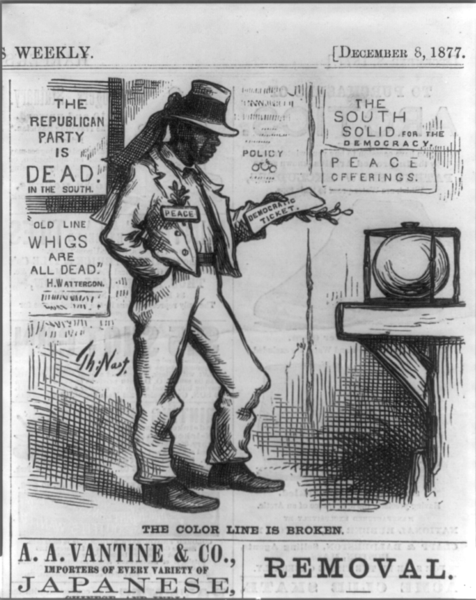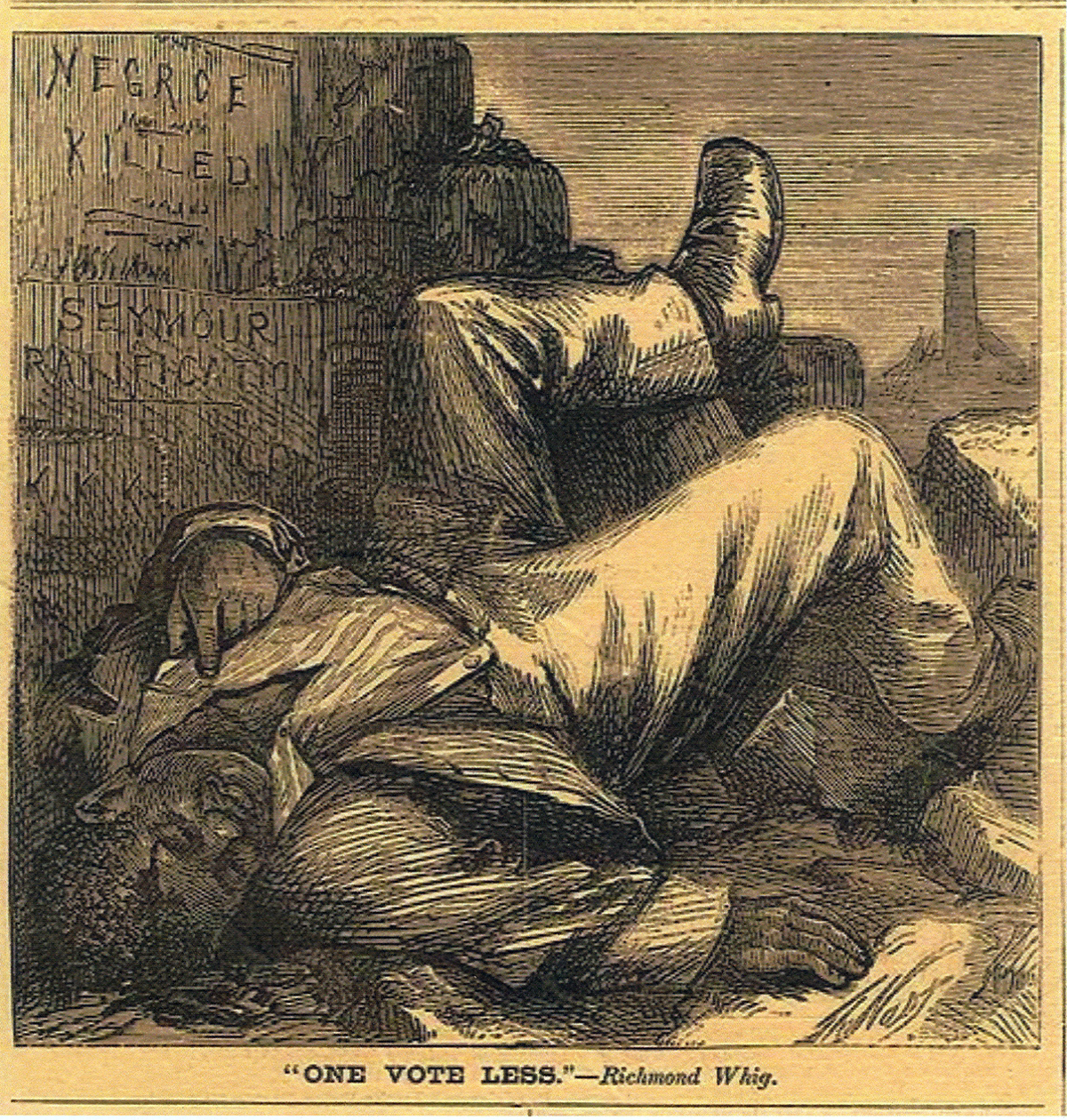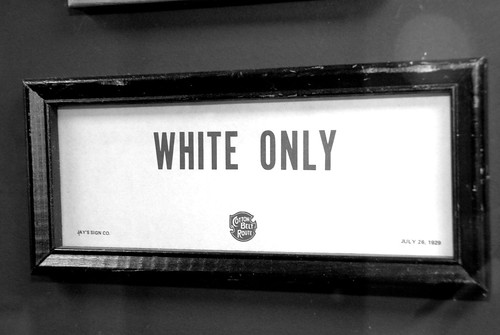
Techniques of Direct Disenfranchisement, 1880-1965
"Direct" disenfranchisement refers to actions that explicitly prevent people from voting or having their votes counted, as opposed to "indirect" techniques, which attempt to prevent people's votes from having an impact on political outcomes (e.g., gerrymandering, ballot box stuffing, stripping elected officials of their powers).
The 15th Amendment prohibited explicit disenfranchisement on the basis of race or prior enslavement. So Southern states devised an array of alternative techniques designed to disenfranchise blacks and, to a lesser extent, poor whites. There were three broad, overlapping phases of the disenfranchisement process. From 1868-1888, the principal techniques of disenfranchisement were illegal, based on violence and massive fraud in the vote counting process. Starting in 1877, when Georgia passed the cumulative poll tax, states implemented statutory methods of disenfranchisement. From 1888-1908, states entrenched these legal techniques in their constitutions. Here we explore the principal means of direct disenfranchisement, and the attempts to use Federal law to prevent disenfranchisement, through 1965, when the Voting Rights Act was passed. For the most part, until the advent of the Civil Rights Movement in the 20th c., the Supreme Court acquiesced in the methods used to disenfranchise blacks by gutting the Federal laws enacted to protect blacks. Whenever it resisted, the Southern states followed the motto "if at first you don't succeed. . . ."

Violence
Violence was a principal means of direct disenfranchisement in the South before Redemption. In 1873, a band of whites murdered over 100 blacks who were assembled to defend Republican officeholders against attack in Colfax, Louisiana. Federal prosecutors indicted 3 of them under the Enforcement Act of 1870, which prohibited individuals from conspiring "to injure, oppress, threaten, or intimidate any citizen with intent to prevent or hinder his free exercise and enjoyment of any right or privilege granted or secured to him by the constitution or laws of the United States." The Supreme Court dismissed the indictments in U.S. v. Cruikshank, 92 U.S. 542 (1875), faulting them for failure to identify a right guaranteed by the federal government that had been violated in the slaughter: (1) Conceding that the right to assemble for the purpose of petitioning Congress or vote in federal elections was derived from the federal government, the Court argued that the right to participate in state politics was derived from the states, so individuals could look only to the states for protection of this right. (2) Conceding an exception, that the U.S. Constitution grants individuals the right against racial discrimination in the exercise of their rights to participate in state politics, the Court faulted the indictment for failure to charge a racial motivation for interference in the victims' right to vote (even though the racial motive was obvious). (3) In any event, the Court ruled that this federal right against racial discrimination was enforceable against the states only, not against individuals. (4) Other rights violated in the slaughter, such as the rights to life and against false imprisonment, were not derived from the federal government, so individuals had to resort to the states for protection of these rights. Cruikshank "rendered national prosecution of crimes against blacks virtually impossible, and gave a green light to acts of terror where local officials either could not or would not enforce the law." (Eric Foner, Reconstruction, 1989, 531).

Fraud
Electoral fraud by ballot box stuffing, throwing out non-Democratic votes, or counting them for the Democrats even when cast for the opposition, was the norm in the Southern states before legal means of disenfranchisement were entrenched. Between 1880 and 1901, Congress seated 26 Republican or Populist congressional candidates who had been "defeated" through electoral fraud. (Kousser, Shaping of Southern Politics, 263). In a key test of federal power to prohibit fraud in state elections, prosecutors brought indictments, under the Enforcement Act of 1870, against two inspectors of elections in Kentucky, for their refusal to receive and count the vote of a black elector in a city election. The Supreme Court dismissed the indictments in U.S. v. Reese, 92 U.S. 214 (1875). It eviscerated the Enforcement Act by throwing out its provisions for punishing election officials for depriving citizens of their voting rights, on the ground that they exceeded Congress' power to regulate elections. (The provisions stated that officials shall be punished for failure to count the votes of eligible electors, when the 15th Amendment granted Congress only the power to punish officials for depriving electors of the right to vote on account of race.) Although electoral fraud remained common in the South, it brought its practitioners under the glare of unfavorable publicity. This motivated a turn to legal means of disenfranchisement.
Poll Taxes
Georgia initiated the poll tax in 1871, and made it cumulative in 1877 (requiring citizens to pay all back taxes before being permitted to vote). Every former confederate state followed its lead by 1904. Although these taxes of $1-$2 per year may seem small, it was beyond the reach of many poor black and white sharecroppers, who rarely dealt in cash. The Georgia poll tax probably reduced overall turnout by 16-28%, and black turnout in half (Kousser, The Shaping of Southern Politics, 67-8). The purpose of the tax was plainly to disenfranchise, not to collect revenue, since no state brought prosecutions against any individual for failure to pay the tax. In 1937, a white man brought suit against Georgia's poll tax, alleging violations of the 14th Amendment and the 19th Amendment (prohibiting discrimination in the right to vote on account of sex). (Women not registered to vote were exempt from the poll tax). The Supreme Court rejected his arguments in Breedlove v. Suttles, 302 U.S. 277 (1937), disingenuously claiming that it was unrelated to any attempt to disenfranchise. It held that the poll tax was a legitimate device for raising revenue, and that the 19th Amendment regulated voting, not taxation. Although the 24th Amendment prohibited the poll tax in Federal elections, even that wasn't enough to prevent a last-ditch attempt to burden the right to vote with a tax. In Harman v. Forssenius, 380 U.S. 528 (1965), the Court struck down a Virginia law requiring federal electors to file burdensome paperwork if they did not pay a poll tax. It took the Voting Rights Act of 1965 to prohibit the poll tax in state elections. The Supreme Court independently declared poll taxes an unconstitutional violation of the equal protection clause of the 14th Amendment in Harper v. Virginia State Bd. of Elections, 383 U.S. 663 (1966).
Literacy Tests
The first implicit literacy test was South Carolina's notorious "eight-box" ballot, adopted in 1882. Voters had to put ballots for separate offices in separate boxes. A ballot for the governor's race put in the box for the senate seat would be thrown out. The order of the boxes was continuously shuffled, so that literate people could not assist illiterate voters by arranging their ballots in the proper order. The adoption of the secret ballot constituted another implicit literacy test, since it prohibited anyone from assisting an illiterate voter in casting his vote. In 1890, Southern states began to adopt explicit literacy tests to disenfranchise voters. This had a large differential racial impact, since 40-60% of blacks were illiterate, compared to 8-18% of whites. Poor, illiterate whites opposed the tests, realizing that they too would be disenfranchised. To placate them, Southern states adopted an "understanding clause" or a "grandfather clause," which entitled voters who could not pass the literacy test to vote, provided they could demonstrate their understanding of the meaning of a passage in the constitution to the satisfaction of the registrar, or were or were descended from someone eligible to vote in 1867, the year before blacks attained the franchise. Discriminatory administration ensured that blacks would not be eligible to vote through the understanding clause. However, illiterate whites also felt the impact of the literacy tests, since some of the understanding and grandfather clauses expired after a few years, and some whites were reluctant to expose their illiteracy by publicly resorting to them. The Supreme Court struck down Oklahoma's grandfather clause in Guinn v. U.S., 238 U.S. 347 (1915), as an obvious ruse to evade the 15th Amendment. Oklahoma responded to Guinn by passing a law requiring all those who had not voted in the 1914 election (when the grandfather clause was still in effect) to register to vote within 11 days, or forever forfeit the franchise. The Supreme Court invalidated this arrangement in Lane v. Wilson, 307 U.S. 268 (1939). None of this touched the literacy tests, only the white exemption from it. Not until 1949 in Davis v. Schnell, 81 F. Supp. 872, did a Federal court strike down discriminatory administration of a literacy test. In Lassiter v. Northampton Cty. Bd. of Ed., 360 U.S. 45 (1959), the Court upheld the Constitutionality of literacy tests, notwithstanding their differential racial impact, provided states were willing to have their impact fall on illiterate whites as well. Congress abolished literacy tests in the South with the Voting Rights Act of 1965, and nationwide in 1970.

Restrictive and Arbitrary Registration Practices
Southern states made registration difficult, by requiring frequent re-registration, long terms of residence in a district, registration at inconvenient times (e.g., planting season), provision of information unavailable to many blacks (e.g. street addresses, when black neighborhoods lacked street names and numbers), and so forth. When blacks managed to qualify for the vote even under these measures, registrars would use their discretion to deny them the vote anyway. Alabama's constitution of 1901 was explicitly designed to disenfranchise blacks by such restrictive and fraudulent means. Despite this, Jackson Giles, a black janitor, qualified for the vote under Alabama's constitution. He brought suit against Alabama on behalf of himself and 75,000 similarly qualified blacks who had been arbitrarily denied the right to register. The Supreme Court rejected his claim in Giles v. Harris, 189 U.S. 475 (1903). In the most disingenuous reasoning since Plessy v. Ferguson, 163 U.S. 537 (1896) (rejecting a challenge to state-mandated racial segregation of railroad cars, on the ground that blacks' claims that segregation was intended to relegate them to inferior status was a figment of their imaginations), Justice Oliver Wendell Holmes put Giles in a catch-22: if the Alabama constitution did indeed violate the 15th Amendment guarantee against racial discrimination in voting, then it is void and Giles cannot be legally registered to vote under it. But if it did not, then Giles' rights were not violated. But, in the face of Giles' evidence of fraud, the Court cannot assume that the constitution is valid and thereby order his registration in accordance with its provisions. Holmes also held that Federal courts had no jurisdication over state electoral practices, and no power to enforce their judgements against states. Undaunted, Giles filed suit for damages against the registrars in state court, and also petitioned the court to order the registrars to register him. The state court dismissed his complaints and the Alabama Supreme Court affirmed, offering another catch-22: if Alabama's voting laws violated the 14th and 15th Amendments as Giles alleged, then the registrars had no valid laws under which they could register him. But if the laws were valid, then the registrars enjoyed immunity from damages for the ways they interpreted them. The Supreme Court affirmed this decision in Giles v. Teasley, 193 U.S. 146 (1904).

The White Primary
Disenfranchisement brought about one-party rule in the Southern states. This meant that the Democratic nominee for any office was assured of victory in the general election, shifting the real electoral contest to the party primary. This fact provided yet another opportunity to disenfranchise blacks. Texas passed a law forbidding blacks from participating in Democratic primary elections. The Supreme Court struck down this law as a plain violation of the 14th and 15th Amendments in Nixon v. Herndon, 273 U.S. 536 (1927). So Texas passed another law providing for each party's state executive committee to determine who could vote in its primaries. Accordingly, the Texas Democratic Party Executive Committee resolved to permit only white Democrats to participate in its primary. The idea was that, as a private association, the party executive committee was not subject to the 14th and 15th Amendments, which applied only to the states. The Supreme Court rejected this reasoning in Nixon v. Condon, 286 U.S. 73 (1932), holding that the Texas Democratic Party Executive Committee got its power to determine party membership from the state of Texas, and so acted as state officials. The State Democratic Convention promptly met and passed a resolution limiting party membership to whites. This was enough to satisfy the Supreme Court that only private parties, not the state, were involved in determining primary electors (despite the fact that the state required and regulated primaries). It therefore upheld the exclusion of blacks from the Texas Democratic primary in Grovey v. Townsend, 295 U.S. 45 (1935). However, in U.S. v. Classic, 313 U.S. 299, a case involving electoral fraud in a primary election, the Supreme Court acknowledged that primary elections were such an integral part of the selection of government officeholders that federal laws guaranteeing the right to vote applied to them. The conflict between Grovey and Classic was resolved in Smith v. Allwright, 321 U.S. 649 (1944), which found that primary elections were so pervasively regulated by the state that, in doing their part to run primaries, political parties were state actors and thus subject to the 14th and 15th Amendments. Texas Democrats evaded this ruling by arrangement with the all-white Jaybird Democratic Association (a leadership caucus within the party), which held elections unregulated by the state. The winner of the Jaybird Party election would enter the Democratic party primary, and the Democratic party would put up no opposition, thus ensuring victory to the Jaybird Party candidate. The Supreme Court saw through this ruse in Terry v. Adams, 345 U.S. 461 (1953), finally putting an end to the white primary after 9 years of acquiescence and 26 years of litigation.

The history of black disenfranchisement demonstrates that it was a product not simply of the actions of Southern states and individuals, but of a failure to uphold and exercise federal power. Congress failed to fully exercise its powers under the 14th amendment (for example, it never reduced Southern states' congressional representation in proportion to its illegal disenfranchisement, as it was authorized to do). The Supreme Court actively undermined federal executive powers to protect black voting rights, refused to acknowledge racial discrimination even when it was obvious, and acquiesced in blatant constitutional violations by resorting to specious reasoning. Although it slowly came around in some cases, historian Eric Foner's judgment, that reconstruction is "America's unfinished revolution" remains true to this day. Click on the right arrow below to survey contemporary techniques of disenfranchisement. (source: University of Michigan)
The information on this page draws from: J. Morgan Kousser, The Shaping of Southern Politics: Suffrage Restriction and the Establishment of the One-Party South, 1880-1910 (Yale UP, 1974) and Samuel Issacharoff, Pamela Karlan and Richard Pildes, The Law of Democracy (Foundation press, 1998).
No comments:
Post a Comment